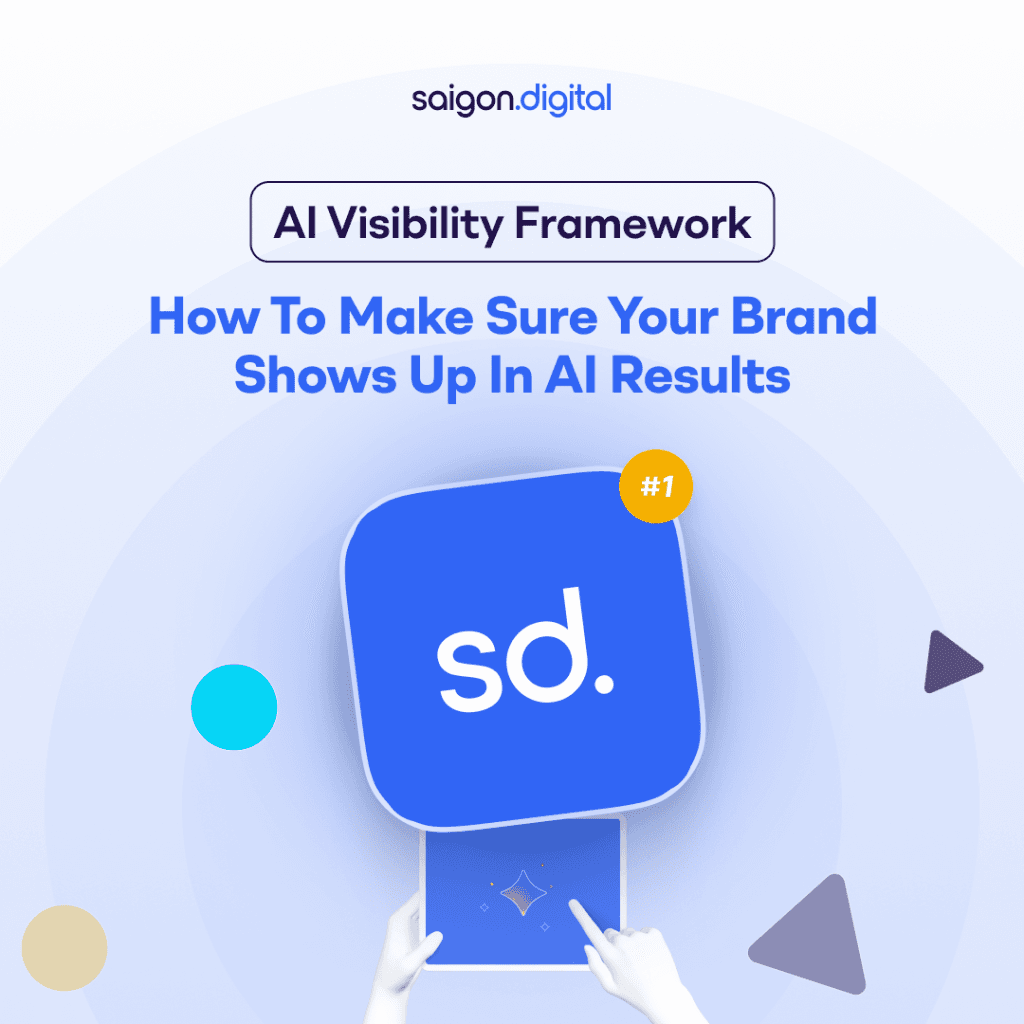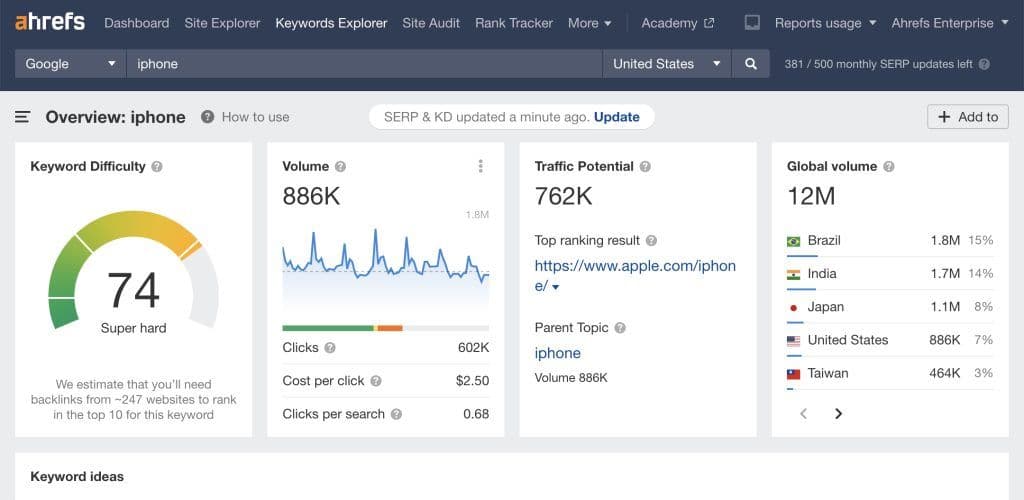
What Is AI Visibility?
Before diving into frameworks, let’s define our core term. AI visibility refers to how often, how prominently, and with what context your brand, content, or domain is cited by AI-powered systems. Unlike traditional SEO , where you aim to rank on page one of Google and attract clicks, AI visibility is about being included in the answers and summaries that AI tools generate, often bypassing the traditional click. For example: You ask ChatGPT: “ What are the best SEO agencies in Ho Chi Minh City? ” The AI system generates a concise answer and cites a handful of agencies. You would want your agency to be on this list. Or when you type the same question into Google and Google’s AI Overview shows you a list of agencies. That is AI visibility in action. It helps to think in terms of two related but distinct sub-goals:- AI Brand Mentions (unlinked references): when AI names your brand in its answer, even if no clickable link is provided.
- AI Citations / Source Mentions (linked references): when AI pulls content from your site or attributes a statement to your brand or pages, ideally with a hyperlink.

The AI Visibility Framework (Pyramid Approach)
At Saigon Digital, we like to think of AI visibility as a layered pyramid (or multi-tiered system) with three core levels. Each level builds on the one below. Level Focus Goal Base Traditional SEO and site readiness Ensure your content is discoverable, indexable, and competitive in SEO so AI can find it Middle Contextual content and AI-centric formats Build content in contexts and structures that AI is likely to reference Top Trust, authority, amplification Amplify your brand, reputation, and authority so AI systems prefer to cite you Let us explain each level in turn, with examples and actions.1. Base Level: Traditional SEO and Technical Readiness
This foundational layer ensures your site can be crawled, understood, and ranked because without it, AI systems have no chance to cite your content. Key focus areas:Indexability and Crawl Access
Do not block AI crawlers such as those used by ChatGPT, Perplexity, or Google’s generative AI from accessing your pages. That means checking robots.txt , noindex tags, or other restrictions. Some SEO practitioners suggest even explicit allowances for “ChatGPT-User” or “PerplexityBot” user agents.Strong Site Structure and Linking
Use a clear, hierarchical website structure, with internal linking and topical clusters. This helps search engines and downstream AI models understand relationships between pages and entities.Metadata, Schema Markup and Entity Signals
Use structured data (Schema.org) where possible (e.g. Article , FAQ , Product , Organisation ). Structured markup helps machines parse and interpret your content more reliably. Include your brand identity, contact info, logo, etc.
Content Quality and Relevance
Make sure your pages are well-written, factually accurate, updated frequently, and aligned with user intent. Use clear headings, succinct introductions, and high semantic clarity (i.e. avoid ambiguity). Lighter signals matter more in AI context, so clarity is critical. Once your base is solid, AI systems can actually find your pages and regard them as eligible sources.2. Middle Level: Contextual Content and AI-Friendly Structure
With foundational SEO in place, the next step is to seed your domain with content that is well aligned with the prompts, contexts, and patterns by which AI discovers and references information. This is where many brands fall short, they rely purely on product pages or blog posts not suited for AI extraction. Key tactics:Prompt-Driven Content
Think like AI: what queries do your prospects ask? Write pages in those question + answer formats. Examples:- “What is generative engine optimisation?”,
- “How to choose an SEO agency in HCMC”,
- “Pros and cons of local SEO vs national SEO”.
Comparison and List Content
AI often surfaces “best of”, “top X”, and comparison pages. When your brand appears in independent roundups, e.g. “Top 5 SEO agencies in Vietnam”, AI is more likely to cite you. For example: “Saigon Digital vs Agency B: which is better for small businesses?” — such pages are citation magnets.Contextual Mentions and Entity Weaving
Within your content, reference other relevant brands, jargon, tools, or industry terms as entities. This helps the AI model situate you in the broader domain network. For example: “We compare Saigon Digital, BigOrange SEO, and Mekong Media in terms of local SEO pricing in HCMC.”Refresh and Repurpose
Update older content with new signals, new data, and new product names. Also repurpose content into formats AI likes (summaries, bullet lists, FAQs). Quick refreshes may improve your chance of being re-discovered. Models like ChatGPT or Gemini may re-crawl or re-evaluate newer content faster.Multi-Format Content
AI doesn’t only read text. It also references images, videos, transcripts, case studies, data visualisations. Posting videos on YouTube, embedding transcripts, infographics, interviews, etc., increases your chance of being sourced.3. Top Level: Trust, Authority and Amplification
At this stage, you are actively influencing why AI should prefer your brand over rivals. This is about earning reputation, amplification, and signals of authority . Critical strategies:Brand Mentions and Media Citations
Increase your brand presence in the wider web with press features, guest posts, industry reports, reviews, podcasts. AI models derive much of their “knowledge” from web text. The more your brand is mentioned across authoritative sources, the more likely AI will learn about it.Backlinks with Branded Anchor Text
While pure links are less dominant than brand mentions, they still matter. When other sites link to you with your brand name (e.g. “Saigon Digital”), AI systems see that anchor text signal.Thought Leadership and Signature Content
Publish unique, high-value assets: whitepapers, original studies, industry benchmarks, tools. These are more likely to become canonical sources that get referenced or summarised by AI engines.Citations in Third-Party Rankings or Directories
Be included in directories or lists (“Top SEO Agencies in Asia”, “Vietnam Digital Firms 2025”). These independent rankings are often scraped or used by AI as signal sources.Social Signals and Engagement
While not a direct causal factor, active sharing, mentions on social media or community platforms (Reddit, LinkedIn, forums) help distribute your content and create tangential signals that AI may ingest. Putting it all together: each month, you might execute one base improvement (e.g. restructure your site), one middle tactic (e.g. publish a prompt-style FAQ), and one top tactic (e.g. guest post in a niche publication). Over time, you build a compound presence that AI systems can’t ignore.Measuring Your AI Visibility
You cannot improve what you do not measure. Here are key metrics and tools you should track:1. Share of Voice vs Competitors
It’s not enough to know that your brand shows up; you also need to compare your visibility against competitors. This “share of voice” analysis reveals whether AI assistants consider your brand one of the leading names in your niche, or if rivals dominate the conversation. For example, if you appear only once in five queries while a competitor appears three times, it signals a gap in authority or presence. By benchmarking against competitors, you can identify where your brand falls short and adjust your strategy to close the gap.2. Growth Over Time
AI visibility should be seen as a long-term metric, not just a one-off snapshot. Tracking your mentions and citations over time will reveal whether your efforts are moving the needle. Are you showing up in more AI-generated answers month by month? Are those mentions becoming more authoritative, such as being used as a primary source rather than a secondary mention? Monitoring growth helps validate that your strategy is working and provides evidence to refine future campaigns. If growth stalls, it may suggest that your content has become outdated or that your competitors are advancing faster.3. Backlinks and Brand Mentions Off-site
AI models learn not only from your own site but also from how the wider web talks about you. This makes off-site brand mentions and backlinks critical to visibility. Monitoring how often your brand is referenced on blogs, news sites, forums, or social media can provide a good indicator of whether AI is likely to “know” and trust you. SEO tools such as Ahrefs or Semrush allow you to track branded anchor text, new backlinks, and even unlinked mentions of your brand. These signals create a broader digital footprint, which in turn increases the chance that AI systems will incorporate you into their responses.





